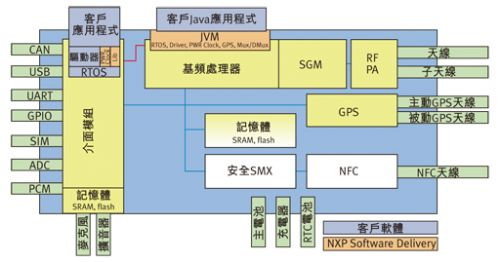The automotive communications industry is about to undergo major changes, and many emerging markets are beginning to emerge, including: emergency call systems (eCall), stolen vehicle tracking (SVT), intelligent traffic management, road tolls, and vehicle-to-infrastructure (Car 2) Infrastructure). This article refers to the address: http:// All markets require low-cost automotive communication solutions for On Board Units (OBUs) and embedded OEM solutions, and data rate requirements do not exceed GPRS. To achieve the lowest system cost, a new architecture with a minimum form factor (eg internal antenna, built-in SIM card) is required. At the same time, major technological changes are taking place in the mobile market, and the system integration of mobile chipsets is progressing rapidly. In the automotive industry, the added value of module manufacturers and Tier 1 suppliers in the integration of mobile communication systems is therefore out of the mainstream, and will only exist in the early application phase of the system (HSP+ or LTE). These two trends will promote some standardization in the automotive communications market, which will initially appear in cost-sensitive low-end markets, but will gradually move toward higher data rate markets. The large number of OEMs and Tier 1 suppliers will establish an economic scale structure to achieve cost reduction. In addition to integrating the standard features of the vehicle communication system (such as pure GSM and GPS functions), other system features will become the same or even more important. In order to make the system not limited to a single use case, the service capability of simultaneously operating multiple applications will obviously become a key requirement. In addition to this resiliency, open standards for service programming have become important in order for different parts of the organization or partners to be able to program services. By implementing such non-proprietary open standards, interoperability challenges are also easier to resolve, thereby facilitating the achievement of third-party services or applications. The main concern of vehicle communication terminal users is privacy or proper control of privacy rights. For many use cases, transaction security and data and code security are also very important. The telematics processing module can be viewed as a digital portal into a car or application and therefore requires the protection of a wall. These requirements for a robust safety architecture and the implementation of a detection tamper detection device help to form a chain of trust between the parties involved in the vehicle communication value chain (including end-user, automotive, vehicle communication and information service vehicle units). Platform, operator, service provider, etc.). To meet this segment of the market segment, a range of common features and flexibility must be provided to meet the integration needs of different levels. NXP's ATOP 2.5G first-generation automotive unit platform solution was developed for this purpose. ATOP 2.5G is a multi-core complete solution for automotive communication applications that combines GSM/GPRS, GPS, SRAM and flash memory; one based on ARM7 automotive microcontrollers, providing CAN, USB and multiple serial processing Bus; a SmartMX security controller based on the bank's standard security level; and an RFID interface based on the NFC standard. The ATOP 2.5G integrates all the frequency generators and filters required for independent operation, as well as the voltage generation circuits of their different components, in a 33 x 33 mm LGA package with a thickness of less than 3 mm. To meet the cost, form factor, in-vehicle connectivity and power consumption requirements of garage communication applications, ATOP 2.5 is optimized and provides integrated standard software to ensure GSM certification and compliance with government requirements. Industry standards and quality requirements. The main application and design logic will be based on Java. It is easy to move, provides efficient and efficient back-end server communication coding, and is highly secure from the sand-box concept and adheres to open standards. Applications using Java can significantly improve and simplify the GSM authentication process. The ATOP 2.5G is equipped with some of the proprietary extensions of the standard JSR for easy programming, with a special focus on application logic and back-end communication. For real-time tasks and low-level system integration, interface-based microcontrollers based on industry-standard ARM architectures support flexible, fully customizable software that can be reused for tools and resources. For interface microcontrollers, NXP will provide a database of communication functions. When there is a Java-generated application on the host processor, the application running on the controller can communicate through multiple logical channels through a multitasking high-speed SPI connection. Transparent communication is carried out. The database also contains power management on the ATOP system. Customers have complete control over the microcontroller and choose the operating system, services and applications that suit their needs. The industry-standard Java-based secure operating system on SmartMX allows multiple secure Javacard applets to coexist, ensuring program code, application or transaction security, and fully embedded into a trusted configuration environment with an industry-standard trust center. . Combined with the NFC RFID interface, ATOP makes it easier to perform secure identification or secure transactions, such as payment processes. Future ATOP is also expected to support new NFC-enabled credit card applications. At present, a Telebox Mini reference design with integrated debug board and integrated development environment accelerates the design of the ATOP system, allowing designers to integrate additional functions such as accelerometers, antenna detection and advanced audio to further enhance the value of the in-vehicle communication system. . Figure: Highly integrated ATOP solution designed for in-vehicle communication systems. Multi function remote manual pulse generator for control of all axes. Manual Sensor,Miniature Optical Kit Encoder,Rotary Encoder With Led Ring,Optical Quadrature Encoder Yuheng Optics Co., Ltd.(Changchun) , https://www.yhencoder.com